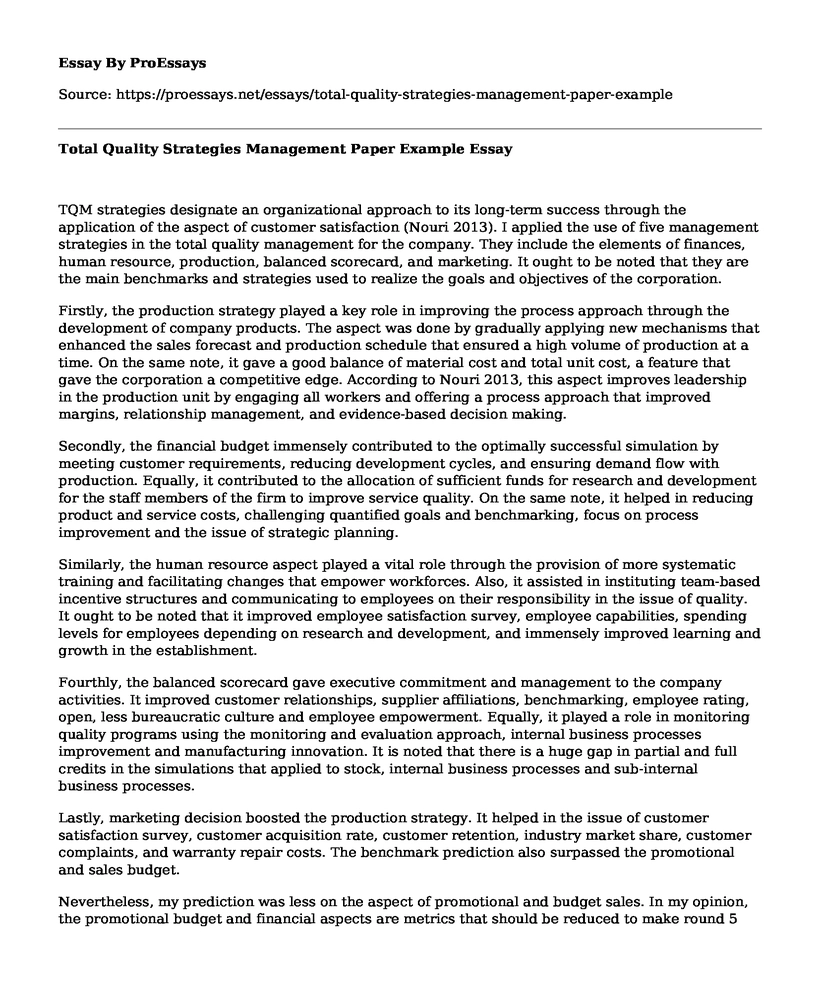TQM strategies designate an organizational approach to its long-term success through the application of the aspect of customer satisfaction (Nouri 2013). I applied the use of five management strategies in the total quality management for the company. They include the elements of finances, human resource, production, balanced scorecard, and marketing. It ought to be noted that they are the main benchmarks and strategies used to realize the goals and objectives of the corporation.
Firstly, the production strategy played a key role in improving the process approach through the development of company products. The aspect was done by gradually applying new mechanisms that enhanced the sales forecast and production schedule that ensured a high volume of production at a time. On the same note, it gave a good balance of material cost and total unit cost, a feature that gave the corporation a competitive edge. According to Nouri 2013, this aspect improves leadership in the production unit by engaging all workers and offering a process approach that improved margins, relationship management, and evidence-based decision making.
Secondly, the financial budget immensely contributed to the optimally successful simulation by meeting customer requirements, reducing development cycles, and ensuring demand flow with production. Equally, it contributed to the allocation of sufficient funds for research and development for the staff members of the firm to improve service quality. On the same note, it helped in reducing product and service costs, challenging quantified goals and benchmarking, focus on process improvement and the issue of strategic planning.
Similarly, the human resource aspect played a vital role through the provision of more systematic training and facilitating changes that empower workforces. Also, it assisted in instituting team-based incentive structures and communicating to employees on their responsibility in the issue of quality. It ought to be noted that it improved employee satisfaction survey, employee capabilities, spending levels for employees depending on research and development, and immensely improved learning and growth in the establishment.
Fourthly, the balanced scorecard gave executive commitment and management to the company activities. It improved customer relationships, supplier affiliations, benchmarking, employee rating, open, less bureaucratic culture and employee empowerment. Equally, it played a role in monitoring quality programs using the monitoring and evaluation approach, internal business processes improvement and manufacturing innovation. It is noted that there is a huge gap in partial and full credits in the simulations that applied to stock, internal business processes and sub-internal business processes.
Lastly, marketing decision boosted the production strategy. It helped in the issue of customer satisfaction survey, customer acquisition rate, customer retention, industry market share, customer complaints, and warranty repair costs. The benchmark prediction also surpassed the promotional and sales budget.
Nevertheless, my prediction was less on the aspect of promotional and budget sales. In my opinion, the promotional budget and financial aspects are metrics that should be reduced to make round 5 more successful. The total liabilities lie at 69.8%, an aspect that is very high. It should be noted that the percentage of both fixed and current assets should surpass that of total liabilities. The issue is revealed in the balance sheets and pi-charts of the balance sheets. Also, the material cost should be reduced drastically so to avoid budget constraints (Richards 2012). In my view, they should cost at most 12.5 dollars to meet budget demands. Similarly, the aspect of customer accessibility should be put into consideration to improve from a score of 0.0 at a scale of 5.0 to at least 4.0 to realize the company's goals.
Equally, customer awareness is another metric that needs to be improved from a scale of 1.4 to at least 4.0 to increase the market size of the company products in the society. The aspect can be done through promotions, advertisements over televisions and radios, and also participating in charity and communal work. Also, the issue of profits has to be shored up for the company to meet its obligations such as paying salaries, staff motivation through bonuses, buying new stock, and empowering production through research and development for workforces (Kantardjieva 2015). Nonetheless, for TQM to succeed, it must be practiced by all personnel in the departments of production, sales, marketing, research, and development.
References
Kantardjieva, M. (2015). The Relationship between Total Quality Management (TQM) and Strategic Management. Journal of Economics, Business, and Management, 3(5), pp.537-541.
Nouri, M. (2013). A Comprehensive Total Quality Management Strategy AndOrganization. International Journal of Engineering Research and Development, 7(1), pp.94-99.
Richards, J. (2012). Total Quality Management. Business Management and Strategy, 3(2), pp.43-108.
Cite this page
Total Quality Strategies Management Paper Example. (2022, Jul 25). Retrieved from https://proessays.net/essays/total-quality-strategies-management-paper-example
If you are the original author of this essay and no longer wish to have it published on the ProEssays website, please click below to request its removal:
- PESTEL Analysis of Mexico and Norway
- Essay Sample on Ethical Values in the Practice of Leadership in Nursing
- Human Resource and Operation Management Paper Example
- Paper Example on Walmart: Crafting an Effective Business Strategy
- Safety Stock & Spare Parts: Key to Success in Inventory Management - Essay Sample
- Essay Example on Gathering Data for Formative Evaluation: Types & Benefits
- Essay Example on E-Marketing: Reaching Customers Across Borders Quickly







